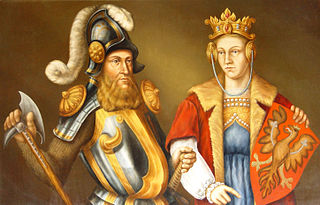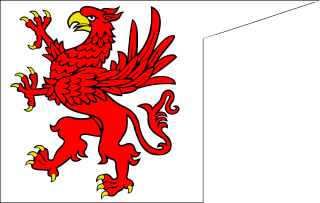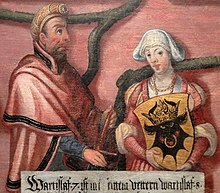
Eric of Pomerania ruled over the Kalmar Union from 1396 until 1439. He was initially co-ruler with his great-aunt Margaret I until her death in 1412. Eric is known as Eric III as King of Norway (1389–1442), Eric VII as King of Denmark (1396–1439) and has been called Eric XIII as King of Sweden. Eric was ultimately deposed from all three kingdoms of the union, but in 1449 he inherited one of the partitions of the Duchy of Pomerania and ruled it as duke until his death in 1459. His epithet of Pomerania was a pejorative intended to insinuate that he did not belong in Scandinavia.

The Duchy of Pomerania was a duchy in Pomerania on the southern coast of the Baltic Sea, ruled by dukes of the House of Pomerania (Griffins). The country existed in the Middle Ages between years 1121–1160, 1264–1295, 1478–1531, and 1625–1637.

The House of Griffin or Griffin dynasty was a dynasty ruling the Duchy of Pomerania from the 12th century until 1637. The name "Griffins" was used by the dynasty after the 15th century and had been taken from the ducal coat of arms. Duke Wartislaw I was the first historical ruler of the Duchy of Pomerania and the founder of the Griffin dynasty. The most prominent Griffin was Eric of Pomerania, who became king of the Kalmar Union in 1397, thus ruling Denmark, Sweden and Norway. The last Griffin duke of Pomerania was Bogislaw XIV, who died during the Thirty Years' War, which led to the division of Pomerania between Brandenburg-Prussia, Sweden and Poland. Duchess Anna von Croy, daughter of Duke Bogislaw XIII and the last Griffin, died in 1660.

Bogislaw V, sometimes known as the Great, was a Duke of Pomerania.

The Schlawe and Stolp Land, also known as Słupsk and Sławno Land, is a historical region in Pomerania, centered on the towns of Sławno (Schlawe) and Słupsk (Stolp) in Farther Pomerania, in present-day Poland.

Pomerania during the Late Middle Ages covers the history of Pomerania in the 14th and 15th centuries.

The Duchy of Pomerania-Wolgast, also known as the Duchy of Wolgast, and the Duchy of Wołogoszcz, was a feudal duchy in Western Pomerania within the Holy Roman Empire. Its capital was Wolgast. It was ruled by the Griffin dynasty. It existed in the Late Middle Ages era from 1295 to 1478.

The Duchy of Pomerania-Stolp, also known as the Duchy of Stolp, and the Duchy of Słupsk, was a feudal duchy in Farther Pomerania. Its capital was Słupsk. It was ruled by the Griffin dynasty. It existed in the High Middle Ages era from 1368 to 1478.

Bogisław VIII, a member of the House of Griffin, was Duke of Pomerania ruling in Pomerania-Stolp from 1395 until his death. He also served as administrator of the Prince-Bishopric of Cammin from 1387 and as Cammin Prince-bishop from 1394 to 1398.

Sidonia von Borcke (1548–1620) was a Pomeranian noblewoman who was tried and executed for witchcraft in the city of Stettin. In posthumous legends, she is depicted as a femme fatale, and she has entered English literature as Sidonia the Sorceress. She had lived in various towns and villages throughout the country.

Ernst Ludwig was duke of Pomerania from 1560 to 1592. From 1569 to 1592, he was duke in the Teilherzogtum Pomerania-Wolgast, sharing the rule over the Duchy of Pomerania with his older brother Johann Friedrich, duke in the other Teilherzogtum Pomerania-Stettin and bishop of Cammin.

Philipp Julius was duke of Pomerania in the Teilherzogtum Pomerania-Wolgast from 1592 to 1625.

The Treaty of Grimnitz was the final settlement of a long-standing dispute between the House of Pomerania and the House of Hohenzollern regarding the legal status and succession in the Duchy of Pomerania. It renewed and amended the Treaty of Pyritz of 1493.
The Treaty of Pyzdry was signed on 2 November 1390 between Władysław II Jagiełło, king of Poland and Wartislaw VII of Pomerania-Stolp. The treaty, signed in Pyzdry, contained an oath of vassalage of Wartislaw to Jagiełło, the obligation to support the latter in the Polish-Teutonic War, and mutual trade alleviations for Pomeranian and Polish merchants. Wartislaw VII, who with his brothers was allied with the Teutonic Order before, received the Polish castellany of Nakło and probably some adjacent areas as a fief.
Duchy of Pomerania-Barth was a feudal duchy of the Holy Roman Empire located in Western Pomerania that existed in the Middle Ages between 1376 and 1478, and between 1569 and 1625. The state consisted of its capital, Barth, and nearby areas. Duchy had separated from Pomerania-Wolgast in 1376 and was incorporated into Duchy of Pomerania in 1478. It was reestablished in 1569 by separation from Pomerania-Wolgast-Stolp and existed until 1625, when it was incorporated into Duchy of Pomerania.

Wartislaw V. was a duke of Pomerania from the House of Griffin. He initially ruled Pomerania-Wolgast jointly with his elder brothers Barnim IV and Bogislaw V. He stood in their shadow and after 1368, he ruled his own part of the Duchy: the Land of Neustettin. Neustettin is now called Szczecinek.

Bogislaw VI, Duke of Pomerania was duke of Pomerania-Wolgast.
Wartislaw VIII was a duke of Pomerania from the House of Griffins house. He ruled in Pomerania-Wolgast from 1394 together with his brother Barnim VI. After Barnim died in 1405, he ruled alone.

The War of the Succession of Stettin was a conflict between the Dukes of Pomerania and the Elector of Brandenburg. It started in 1464, after the death of Duke Otto III, the last Duke of Pomerania-Stettin. The Dukes of Pomerania-Wolgast, Eric II and Wartislaw X, held that they were Otto's rightful heirs. Elector Frederick II of Brandenburg held that Pomerania-Stettin was a fief of Brandenburg. Since its duke, Otto III, had died without a male heir, it should fall back to Brandenburg.

Bogislaw VII was a Duke of Pomerania-Stettin from the House of Griffin.

















